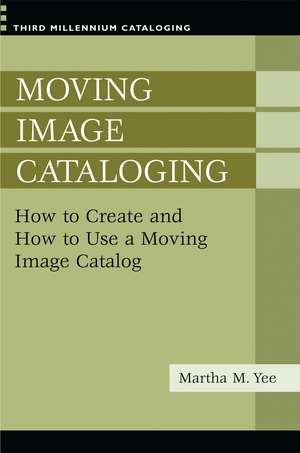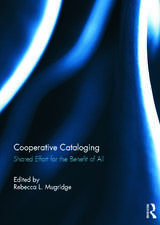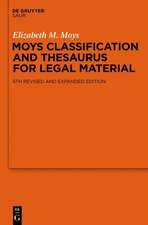Moving Image Cataloging: How to Create and How to Use a Moving Image Catalog: Third Millennium Cataloging
Autor Martha M. Yeeen Limba Engleză Paperback – 29 oct 2007 – vârsta până la 17 ani
Preț: 275.46 lei
Preț vechi: 350.63 lei
-21% Nou
Puncte Express: 413
Preț estimativ în valută:
52.71€ • 55.18$ • 43.61£
52.71€ • 55.18$ • 43.61£
Carte tipărită la comandă
Livrare economică 07-21 aprilie
Preluare comenzi: 021 569.72.76
Specificații
ISBN-13: 9781591584384
ISBN-10: 1591584388
Pagini: 288
Dimensiuni: 178 x 254 x 18 mm
Greutate: 0.6 kg
Editura: Bloomsbury Publishing
Colecția Libraries Unlimited
Seria Third Millennium Cataloging
Locul publicării:New York, United States
ISBN-10: 1591584388
Pagini: 288
Dimensiuni: 178 x 254 x 18 mm
Greutate: 0.6 kg
Editura: Bloomsbury Publishing
Colecția Libraries Unlimited
Seria Third Millennium Cataloging
Locul publicării:New York, United States
Notă biografică
Martha M. Yee is Cataloging Supervisor at the UCLA Film and Television Archive, as well as an adjunct instructor in the Department of Information Studies, Graduate School of Education and Information Studies, University of California, Los Angeles.
Cuprins
IllustrationsIntroductionChapter 1: Introduction to Moving Image CatalogingChapter 2: Introduction to A Data Structure Standard; How to Create a Cataloging Record; Automation Complexities and OPAC SearchingChapter 3: Moving Image Works, Expressions and Manifestations; Introduction to Uniform Titles; Relationships; Represented and Presented WorksChapter 4: Work Identification and Authorship; Authority ControlChapter 5: Complications with Names of Persons and Corporate Bodies; Location of FRBR Entities; OPAC Searching ComplicationsChapter 6: Introduction to Subject AnalysisChapter 7: More on Subject AnalysisChapter 8: Newsfilm access; OPAC searchingChapter 9: Subject Access to Fiction; Genre/Form AccessChapter 10: Digitization and the Future of CatalogingExercise AnswersGlossaryBibliography of Works ConsultedCataloging Standards BibliographyIndex
Recenzii
Encouraging the reader to think critically and be prepared to make decisions in ambiguous situations where the solutions might not always be obvious or clearly dictated by rules, Moving Image Cataloging stimulates critical thinking with exercises at the end of each chapter, providing suggested (but not absolute) answers at the end of the book. Primarily geared for catalogers of moving images, the work also teaches how to make decisions that impact the catalog and, more generally, how to search a catalog.
This is a book which will become a standard work on the subject of cataloguing the moving image, and it needs to be read by those involved in cataloguing in film libraries, archives, and museums, as well as library schools and the more advanced cataloguing courses. Finally, I cannot resist quoting the marvellous dedication at the beginning of the book: 'This book is dedicated to all of the cataloguers who have laboured in the vineyards of bibliographic control for hundreds of years, largely unthanked and unappreciated because, when we do our work well, it is invisible to the catalogue user.'How true!
.this is an excellent overview of the challenges, principles, and practices of cataloging moving image materials. It would be a useful textbook for courses on this topic, as well as for in-library training programs.
Martha Yee is a well-known exponent of moving image cataloguing, and this book is correspondingly authoritative.
This is a book which will become a standard work on the subject of cataloguing the moving image, and it needs to be read by those involved in cataloguing in film libraries, archives, and museums, as well as library schools and the more advanced cataloguing courses. Finally, I cannot resist quoting the marvellous dedication at the beginning of the book: 'This book is dedicated to all of the cataloguers who have laboured in the vineyards of bibliographic control for hundreds of years, largely unthanked and unappreciated because, when we do our work well, it is invisible to the catalogue user.'How true!
.this is an excellent overview of the challenges, principles, and practices of cataloging moving image materials. It would be a useful textbook for courses on this topic, as well as for in-library training programs.
Martha Yee is a well-known exponent of moving image cataloguing, and this book is correspondingly authoritative.













